The most interesting octopus facts concern this underwater animal’s intelligence and ability to learn and master a variety of tasks.
Experiments conducted by animal behaviorists indicate that octopuses or octopi possess a rudimentary sort of both long-term and short-term memory somehow enhanced by its complex nervous system.
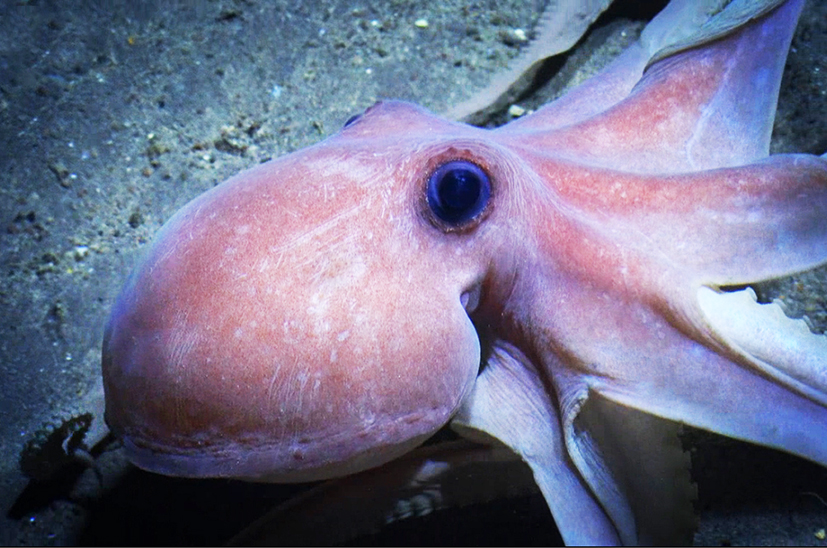
Unlike vertebrates, the octopus brain does not contain the majority of its neurons. Over two-thirds of its neurons are located in its arms’ nerve cords, which explains why octopi can move their arms with little signaling from their brain.
An octopus is technically a cephalopod and a mollusk, a group of animals living in Earth’s oceans. Other animals placed in this category include clams, snails, oysters, mussels and scallops.
Find a lot of beautiful pictures of octopi on the page Octopus Picture, and lots of octopus images on the page Octopus Clipart.
Basic facts regarding octopus anatomy involves traits such as:
• Closed circulatory systems
• Advanced nervous systems and a complex brain
• Well-developed eyesight, hearing and olfactory glands
• Mouths resembling beak-like jaws
• Having internal, missing or reduced shells
• Ability to generate camouflage coloring
• Instead of bones to support its body, a muscular mantle
• A siphon, or funnel, located near the head of an octopus used to propel the octopus in the water when water is forcibly expelled through and out this funnel
Evolution
Invertebrates, such as octopuses and other ocean creatures, represent the origins of the common ancestor to all terrestrial life forms. The evolution of invertebrates allowed the transition of some of these invertebrates into vertebrates, which led to the organized complexity of mammals, primate and eventually humans.
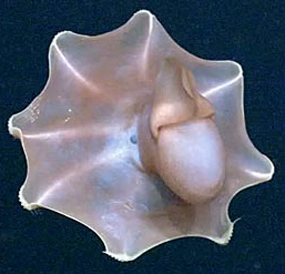
At one point in their evolution, octopuses had shells to protect them from predators but as their intelligence grew and their ability to outwit and outmaneuver predators steadily increased, the need for a shell became negligible.
Ancient ancestors of octopi called ammonites were shelled cephalopods that dominated the seas for millions of years, eventually succumbing to the same mass extinction that killed off the dinosaurs towards the end of the Cretaceous period.
Cool Facts about Octopus
Besides their unique appearance, several characteristics trigger interest in octopuses such as:
• Octopuses have ink sacs that squirt a thick, black ink-like substance at predators, which clouds the water and allows an octopus to make a fast escape. This ink also inhibits a predator’s sense of smell, further facilitating the octopus’s chance to flee from an attack.
• Specialized skin cells capable of changing color to match the environment provide an excellent form of camouflage for octopuses. They also communicate with other octopi by using this ability to change colors.
• Some octopuses can actually cause a limb to detach itself from their body in order to distract dangerous predators. The stump eventually re-grows and the octopus once again has eight arms.
• Octopuses do not live long, with the North Pacific Giant Octopus living the longest at five years as long as the female does not have babies.
• The males live only several months after mating; the females die soon after their eggs hatch.
• Octopus blood is based on copper rather than iron, which is why it appears blue.
• Certain countries do not allow octopi to be used as experimental animals unless anesthesia is first administered.
• As the only invertebrate known to use tools, octopi can unscrew jar lids and distinguish between patterns and colors in laboratory experiments.
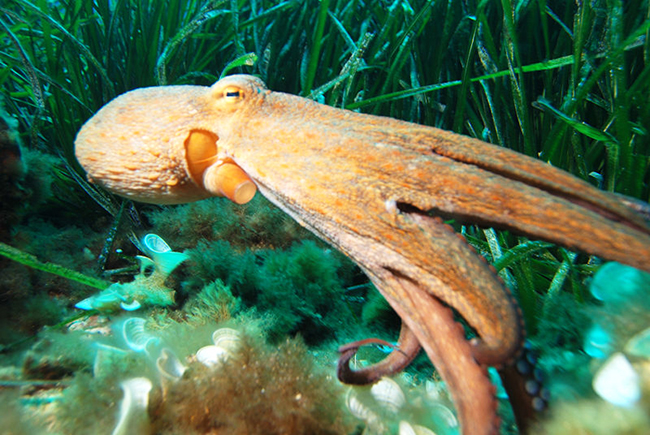
More Interesting Facts about Octopus
Additional facts and information regarding the species and octopus anatomy include:
• Octopuses do not possess any kind of internal or external skeleton.
• About 300 species of this curious animal exist.
• Average weight of an octopus is around 20 pounds.
• The females lay over 100,000 eggs at a time. Predation necessitates laying so many eggs as only a few will survive without being eaten by other sea creatures once they are born. Attempting to blend in with plankton, baby octopuses feed until they grow heavy and sink to the floor. This is referred to as the “settlement” phase of octopus development, and the ocean floor is where they will spend most of their lives.
• All octopi have three hearts: one meant to circulate blood throughout the body and two that keep blood pumping through its gills.
Octopus Habitat Facts
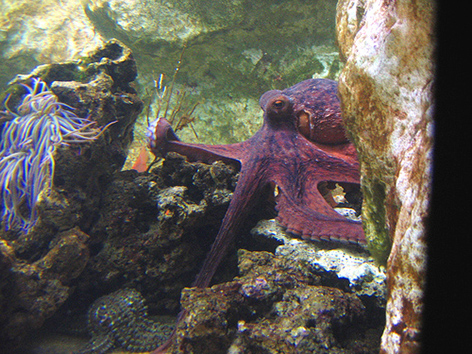
Octopus facts regarding its natural environment include:
• Home to many octopuses is the Pacific or Atlantic Ocean floor, where they can hide in rock dens, crevices and cracks to protect the boneless octopus anatomy.
• They prefer temperate coastal areas such as the Gulf of Mexico, the coasts of Asia and western Africa and the Caribbean coral reefs.
• Because the predominate predators of octopi are whales, sharks and seals, they tend to stay near the bottom of oceans and seas to avoid being attacked and are rarely found far from the safety of a rock den.
• Octopi capture bottom-feeding snails and clams with their suction-cupped arms and suck the meat out of the shells by first puncturing a hole through the shell with its beak-like mouth.
• They only live in salt water.
• The smaller types of octopus live in colder waters.
Octopus facts about strange octopi involve the recent discovery of odd-looking cephalopods off the coast of Antarctica have been dubbed the “psychedelic” octopi because of their unusual coloring. In addition, researchers have found that these octopi possess a particularly potent brand of venom more poisonous than any other of the species.
Octopus Behavior
Studying octopus behavior provides scientists with even more fascinating octopus facts with which to publish and amaze the public. In-depth research into the actual intelligence of octopuses has revealed that even though they have a walnut-sized brain, they possess ten times more brainpower than other animals having such small brains.
Tool Use
Octopi use tools, a cognitively sophisticated operation associated with intelligence. Only humans, primates, dolphins and some birds make and use tools. Researchers have observed octopi carrying both halves of hollowed-out coconut shells around with them until they need to curl up inside the shells as protection from an attacking predator. Octopuses are the only invertebrates capable of tool manipulation.
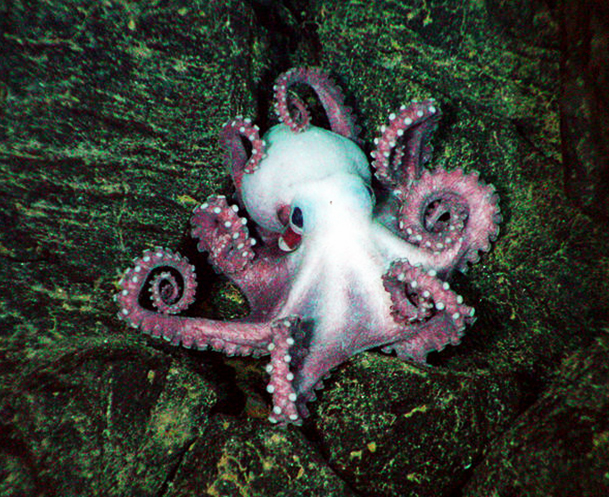
Another sign of octopus intelligence involves the ability of an octopus to slowly swim along the sea floor but adopt a rock-like appearance in order to avoid predation. What surprised researchers was the ability of octopuses to match their speed to the speed of the current. This type of planned behavior requires excellent eyesight, cognitive skills and first-rate coordination.
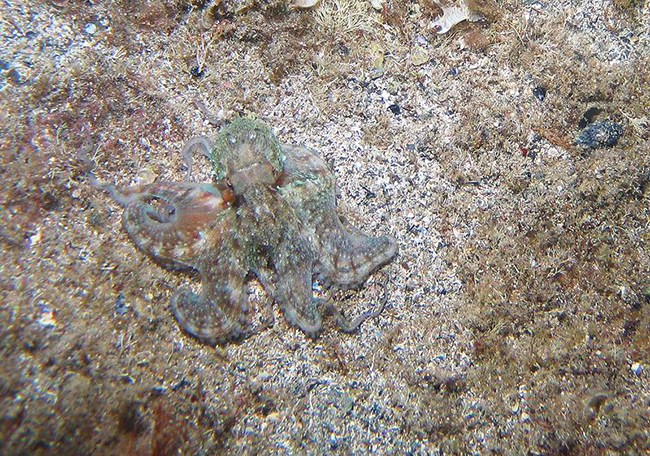
Scientists theorize that an octopus possesses enhanced intelligence due to losing its ancestral shell millions of years ago, which caused the cephalopod to hone its ability to evade and trick predators into leaving it alone.
One of the most interesting octopus facts concerning the creature is that the octopus brains are somewhat wrapped around the esophageal tube, or the gut of the octopus. However, this oddly situated brain is comprised of human-like lobes, gyri and nuclei, which do resemble the type of modular brain seen in higher primates such as humans and apes.
Sense of Play
Octopi have even been observed playing by blowing jets of water from their funnel in order to send a small pill bottle back to the end of the aquarium in which they lived where other jets of water kept sending it back!
They also seem to like to play with Lego blocks, larger building blocks and figuring out how to find the end of a maze.
Reproduction
Every male octopus has a hectocotylus, an arm that contains sperm necessary to fertilize eggs. Once a male has found a mate, he will either remove the arm and give it to the female octopus or put it directly into the oviduct where eggs wait to be fertilized. When a female is given a sperm-filled arm, she stores it in her mantle until the eggs are laid. Then she will take the arm and spread sperm over the thousands of eggs
Octopus facts concerning the maternal instinct reveal that female octopuses are meticulous mothers, caring for these eggs until the babies emerge. By eliminating the need to eat during this time, females keep them clean by constantly blowing fresh water over the eggs as well as chasing away predators wanting to make a meal from the vulnerable eggs. Some species of octopus lay eggs that take only two months to hatch; others may take up to ten months.
After a juvenile octopus emerges, he or she will immediately begin eating microscopic plankton until they grow large enough and settle to the ocean floor. Octopus children grow rapidly, increasing its mass by up to five percent each day. Because many ocean and sea creatures find baby octopi particularly tasty, researchers estimate that perhaps one or two percent of the over 100,000 eggs laid by a female actually reach maturity.
The Caribbean Reef Octopus
Living among colorful coral reefs has given this octopus the exceptional ability to suddenly change color as well as texture in order to blend in with its environment and escape predation. Possessing more chromatophores, which are color-changing cells, than other octopi, the reef octopus can flash an incredible range of hues within seconds, going from bright red to dark green to vivid blue while also becoming smooth-skinned or bumpy skinned.
Weighing an average of three pounds, the Caribbean reef octopus is difficult to find and study due to its secretive and somewhat anti-social nature.
Validated octopus facts involve their fiercely protective nature concerning their personalized lairs. They do not interact with their own kind unless it is time to mate and frequently fights occur when a reef octopus encroaches upon the lair of another reef octopus. As nocturnal foragers, reef octopuses capture and eat lobsters, crabs, shrimp and annelid worms only at night and stay hidden most of the day, avoiding predatory fish, stingrays and sharks.
Male reef octopi engage in elaborate mating dances meant to entice the female. To get the attention of a prospective female, the male will darken its entire body except for one arm, which he illuminates and waves around wildly. If he thinks she is receptive, the male reef octopus will then slowly move towards her, displaying a vivid array of different colors to further tempt her into mating with him.
Blue Ringed Octopus Facts
Inhabiting the warm waters of the Australian coast and western Pacific Ocean, the blue ringed octopus lives longer than most octopuses, with an average age of two years. It is also the most deadly, capable of injecting enough venom from one bite to paralyze and kill a human or any other animal within minutes.
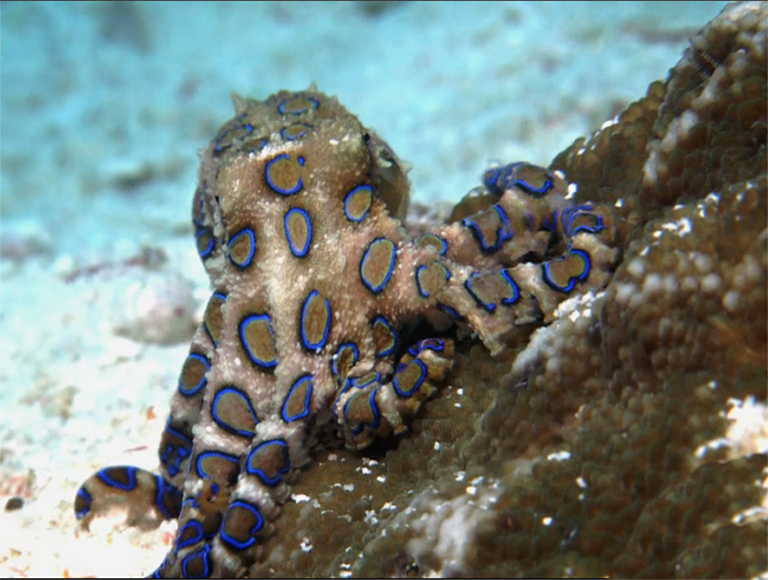
While resting, the blue ringed octopus is gray and brown in color. However, when agitated or frightened, it suddenly pulsates with over 50 vividly blue rings that serve as a warning to whatever is trying to attack it. When this octopus bites, its tetrodotoxin-rich saliva enters the bloodstream of the victim and produces an irreversibly deadly condition. Tetrodotoxin is a neurotoxin also found in newts and puffer fish, which produce symptoms such as:
• Lethargy
• Weakness
• Headache
• Seizures
• Tremors
• Blindness
• Vomiting
• Cardiac arrhythmia
Mostly nocturnal, the blue ringed octopus not only uses rock dens in which to hide but also will burrow into gravel and sand to hide itself from predators or when preying on mollusks and crabs for food. Only three or four documented cases of a human being bitten by one of these highly venomous octopi have been recorded in the past century so the chance of being bitten is considered extremely rare.
Facts about Giant Pacific Octopus
As the largest octopus species on record averaging anywhere from 80 pounds to 155 pounds, the giant octopus has a life span of three to five years, eats abalone, shrimp, fish and clams as well as smaller species of sharks, and exhibit most of the usual traits possessed by other octopus. Researchers are not sure why these octopuses are so much larger than others but do know that they are extremely intelligent, learning how to unscrew jar lids and master mazes in laboratory testing.
Octopus Facts about the Smallest Octopus
Alternatively, the smallest octopus yet to be discovered is called the octopus Wolfi, or pygmy octopus. No more than one inch long, this tiny octopus lives in the Indo-Pacific Ocean and weighs less than .05 of an ounce. Not much is known about the Wolfi but many people have found they make delightful pets and seem to do well in home aquariums.
Mimic Octopus Interesting Facts
Recently discovered in 1998, the mimic Octopus lives in the tropical waters off the coast of Southeast Asia and gets its name from its ability to imitate other aquatic creatures, specifically animals that will deter or frighten predators. Researchers have observed this octopus mimicking sea snakes, flounders, stingrays, sea anemones and lionfish by the way its contorts its arms and body and changes its color.
While all octopi are able to assume different appearances, this was the first time an octopus was seen to imitate other animals. Mimic octopuses prefer living on the muddy, soft bottoms of shallow estuaries and emerge during the day to forage for fish and small crabs.
The Rare Dumbo Octopus
Belonging to the genus Grimpoteuthis, the Dumbo octopus are so named because of the odd-looking fins protruding from the side of their large heads that resemble Disney’s Dumbo elephant ears. They represent some of the rarest octopi and are only found at extreme ocean depths of nearly 2.5 miles below the surface.
However, they have been discovered living in all oceans, always hovering just above the bottom, moving along by flapping their ears and expelling water. Food consists of bivalves, crustaceans and worms, which they swallow whole. Because they dwell in dark and somewhat uncharted regions of the oceans, not much is known about these rare octopi.
Octopuses that Glow in the Dark
Facts about the recently discovered stauroteuthis syrtensis, or the “glow in the dark octopus” generate fascinating speculations as to why this octopus developed the ability to possess bioluminescent tentacles. While octopus cousins the cuttlefish and squid are commonly bioluminescent, it is a rare trait seen in octopi. Surprising to researchers was the fact that this illumination emanates from the suckers of the stauroteuthis syrtensis rather than another part of the body. Ensuing studies into the light-producing suckers revealed that bioluminescent cells had replaced most of the muscle cells in the suckers.
Scientists think that this peculiar kind of octopus anatomy developed bioluminescence when the particular octopus habitat shifted from shallow waters to deeper waters where light could not infiltrate. When these octopi no longer needed the full strength of their suckers to cling to the bottom, cells evolved to emit light that attracted food sources such as crustaceans. Stauroteuthis syrtensis can only be found living in the deep depths of the northern Atlantic Ocean.
Octopus Facts Related to the Human Eye
Zoologists and biologists have long been amazed at the similarities between the octopus eye and the human eye. Both human and octopus eye contain transparent corneas, iris diaphragms capable of regulating light, retinas and focus lenses operated by muscular rings.
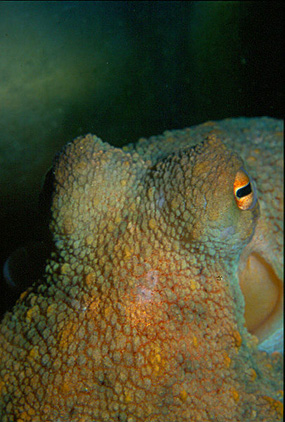
One fascinating difference, however, lies in the shape of the pupils. Cephalopods have horizontal pupils that remain horizontal regardless of the position of the body. Unlike humans, who must interpret what they see according to the eye’s position, octopuses do not need to compensate for positional changes, which keeps their ability to rapidly access visual information consistent and accurate.
Safely Keeping an Octopus as a Pet
Small octopi do well in captivity with proper care. However, owners of pet octopuses should always use octopus facts as guidelines to ensure a healthy and happy octopus:
• Since octopuses are expert escape artists, aquarium coverings should not contain holes larger than your little finger.
• Use fine silver sand instead of coral sand. Octopi like to dig for food and coral sand may damage their skin.
• Provide hiding places in the tank for your octopus, such as caves made from rocks.
• Water salinity should be kept between 1.026 and 1.028 percent. Change the water every two weeks and maintain a Ph level of around 8.2.
• Always use the best skimmers and filters when cleaning the tank since octopi produce excessive amounts of waste.
• Whenever possible, feed your pet octopus fresh crustaceans. Octopus facts tell you that this is their favorite food. The next best alternative to live clams and crabs is thawed shrimp. Avoid feeding octopi goldfish, as they do not contain proper amounts of nutrients to keep a pet octopus optimally healthy.
• Remember that the octopus is an intelligent creature so make sure to provide it with toys such as ping pong balls and blocks with holes in which they can toss or pick up with their arms.
• Octopi love human interaction so find ways to play with your octopus and do not just leave him alone in his tank alone without periodic communication.
Octopus Meat
If you have an octopus as a pet or are just fond of octopuses for their intelligence, it is hard to imagine eating octopus meat. However, many cultures consider octopus as a delicacy, especially in parts of Europe and Asia. Octopus is eaten raw or cooked, but can be chewy and tough when consumed uncooked. Marinating octopus meat is a good way to tenderize it or precooking it in salted water.
As with most seafood, octopus is a low-calorie, highly nutritious food containing 25 grams of protein and only one gram of fat per three ounce serving. The meat also contains rich amounts of vitamin B12, iron, zinc and selenium.
Since octopus meat can be eaten raw, the only danger existing in eating octopus meat is allowing it to spoil. Always make sure it remains frozen or refrigerated.
Octopus Facts versus Octopus Myths
Although myths and legends may not qualify as octopus facts, the Hawaiian creation stories presume the present universe is the final realm in a series of other universes that were destroyed. All animals were eradicated by the destruction of previous universes except the octopus, which is considered the lone survivor of this catastrophic existential process.
Pacific Islander myths include an octopus god called Na Kika whose eight arms facilitated the creation of the earth. By shoving rocks and dirt up from the bottom of the oceans to produce islands and continents, Na Kika allowed humans to live and grow food for sustenance.
From Samoa comes the myth of the demi-god Tae-o-Tagaloa, who is part female and part fe’e, or octopus. Tae-o-Tagaloa is also implicated in the creation of islands as well
As researchers who study this fascinating and often misunderstood creature gather more octopus facts, the reputation of octopuses as being intelligent and possibly sentient creatures continues to grow and enlighten both scientists and laymen. Information regarding octopus behavior and octopus anatomy is also progressing into new areas that provide a deepening appreciation and a sense of awe regarding this fascinating animal who may actually resemble humans more than we realize.
On these page you can find more information about the octopus:
http://animals.nationalgeographic.com/animals/invertebrates/common-octopus/
And here you can find more pictures and clipart of the octopi: